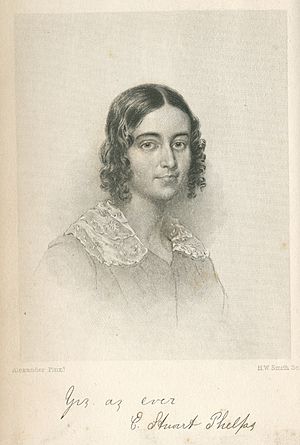Elizabeth Wooster Stuart Phelps facts for kids
Quick facts for kids Elizabeth Stuart Phelps |
|
|---|---|
 |
|
| Born | August 13, 1815 Andover, Massachusetts, US |
| Died | November 29, 1852 |
| Pen name | H. Trusta |
| Occupation | Writer |
| Language | English language |
| Children | including Elizabeth Stuart Phelps Ward |
Elizabeth Wooster Stuart Phelps (1815–1852) was an American writer. She wrote many religious articles, stories about home life for adults, and books for children. She published eleven books and many articles and stories that were translated into different languages. She also wrote many works that appeared without her name.
Phelps was one of the first writers to show the daily life of people in New England. She wrote about the challenges women faced in their roles as mothers and wives. Her story "The Angel Over the Right Shoulder" (1852) showed how hard it was for a wife to follow her creative dreams. It also showed how important it was for women to develop their own minds.
Her daughter, Elizabeth Stuart Phelps Ward, who also became a writer, said her mother felt a constant struggle. This struggle was between her duties as a caretaker and her desire to be a creative artist. Her daughter believed this struggle eventually led to her mother's early death.
Early Life and Education
Elizabeth Stuart Phelps was born in Andover, Massachusetts, on August 13, 1815. Her parents were Moses Stuart and Abigail (Clark) Stuart. Her father was a well-known professor at Andover Theological Seminary. He was important in starting modern Bible studies in America.
Her family history on her mother's side connected her to John Winthrop. He was an English Puritan lawyer and an early governor of the Massachusetts Bay Colony. Elizabeth was also childhood friends with author Harriette Newell Woods Baker. They started a writing club together to share their stories.
In 1829, at age 14, Elizabeth was in the first group of students at Abbot Academy. This was one of the first high schools for girls in the country where students could live. In 1832, she went to Boston's Mount Vernon School. Her teacher there was Reverend Jacob Abbott, a famous writer of children's books. Elizabeth lived with the Abbott family for two years. During this time, she published her first writings. She used the pen name H. Trusta, which was an anagram of her last name, Stuart. Her stories appeared in Abbott's magazine, The Religious Magazine.
After finishing her education in 1834, Elizabeth returned to Andover. She had ongoing health problems like partial blindness, headaches, and sometimes even temporary paralysis. Doctors thought she had a "brain fever." These health issues affected her for the rest of her life. Her daughter later suggested that her mother's health problems were linked to the stress of balancing home duties with her strong desire to write and think.
Adult Life and Writing Career
In 1842, Elizabeth moved back to Boston and married Austin Phelps. Her husband was a respected minister at the Pine Street Church in Boston. She gave birth to her first child, a daughter named Mary Gray. Mary Gray would later become a famous writer, taking on her mother's name after her mother passed away. Elizabeth and Austin had six happy years in Boston.
In 1848, her husband accepted a job at Andover Theological Seminary. This meant he would work alongside Elizabeth's father, Moses Stuart. In 1849, Elizabeth began writing the Kitty Brown books. This was a four-book religious series, and she wrote one book each year.
Just four years later, Elizabeth Phelps passed away. Her husband later shared that she had felt a "foreboding" about how difficult Andover would be for women. During those four years in Andover, Elizabeth gave birth to two more children, Moses and Amos. She also became a bestselling author. Her novel, The Sunny Side; or, The Country Minister's Wife, was published in 1851. It sold 100,000 copies in its first year and eventually over 500,000 copies. This book brought her international fame.
Elizabeth Wooster Stuart Phelps died in Andover on November 30, 1852, at the age of 37. She is buried in the Phillips Academy Cemetery in Andover, Massachusetts.
Works by Elizabeth Stuart Phelps
- Little Kitty Brown and Her Bible Verses. (1851)
- Kitty Brown and Her City Cousins. (1852)
- Kitty Brown and Her Little School. (1852)
- Kitty Brown Beginning to Think. (1853)
- The Sunny Side and a Peep at Number Five. (1853)
- The Sunny Side; or, The Country Minister's Wife. (1851)
- A Peep at Number Five; or, A Chapter in the Life of a City Pastor. (1852)
- The Angel over the Right Shoulder; or, The Beginning of a New Year. (1852)
- The Tell-Tale; or, Home Secrets told by Old Travellers. (1853)
- Little Mary; or, Talks and Tales for Children. (1854)
- The Last Leaf from Sunnyside. (1853)

